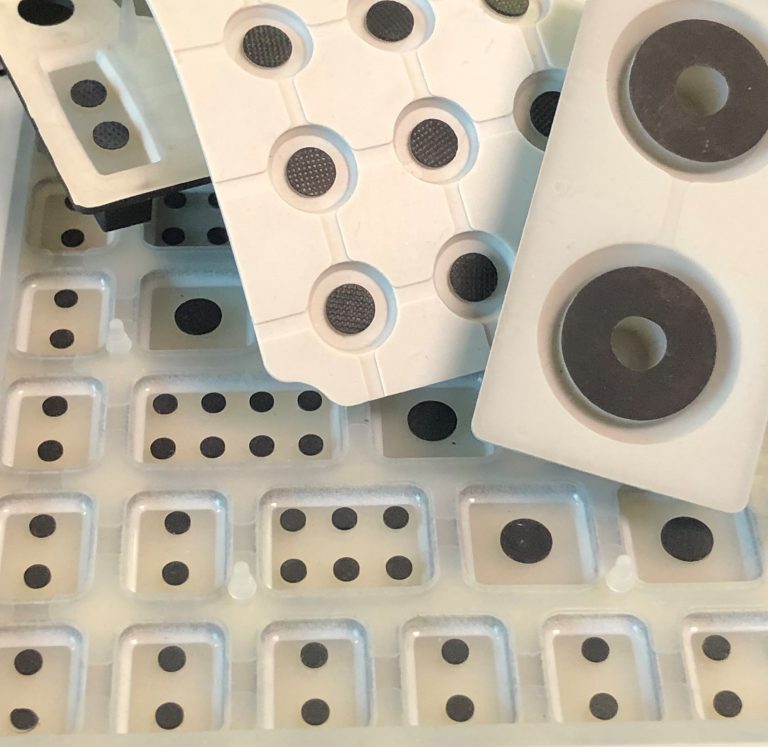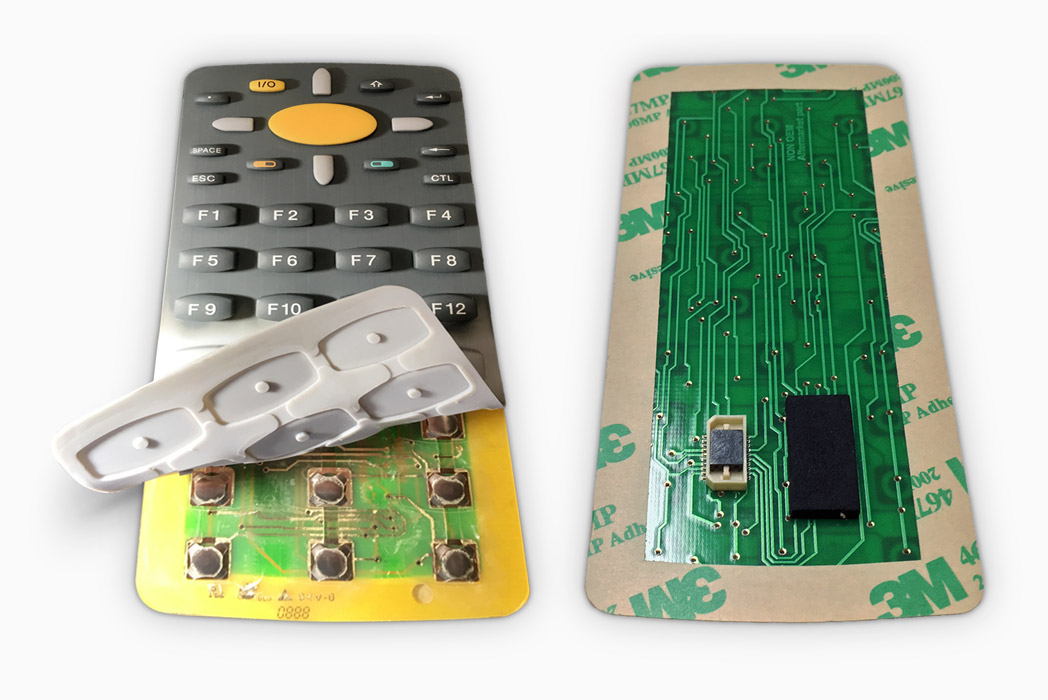A Comprehensive Guide to the Production and Processing of Rubber Keypads for Ideal Performance
The production and handling of rubber keypads play an important role in their efficiency and use. Product choice, layout precision, and innovative manufacturing methods significantly affect their resilience and performance. Recognizing these elements is vital for creating top quality items. As numerous developments arise in this field, exploring their implications might expose new requirements for capability and individual experience. What key aspects will form the future of rubber keypads?
Understanding Rubber Keypads: Products and Kinds
Rubber keypads are important components in countless gadgets, supplying an equilibrium of resilience and responsive feedback. These keypads are mainly made from silicone or synthetic rubber, products chosen for their adaptability and resilience. Silicone rubber, particularly, is favored for its superb temperature resistance and durability, making it perfect for different applications, from consumer electronics to commercial machinery.
There are numerous types of rubber keypads, consisting of dome button keypads, which utilize a dome-shaped system that supplies tactile responses when pushed. Additionally, there are also level keypads, which feature a smooth surface and are frequently made use of in remotes and clinical devices. The option of material and kind affects the keypad's efficiency, really feel, and general individual experience. Understanding these elements is essential for developers and manufacturers aiming to create efficient and trusted interfaces in their products.
The Manufacturing Refine: From Layout to Manufacturing
The production process of rubber keypads entails numerous essential phases, beginning with layout and ending with manufacturing. Designers develop in-depth specs and models, assuring the keypad satisfies functional and aesthetic demands. Computer-aided design (CAD) software application is usually made use of to picture the layout and features prior to continuing.
As soon as the design is completed, product choice is important, with alternatives normally including silicone or all-natural rubber. In the following phase, molds are developed based on the accepted layouts, which will certainly shape the keypads throughout production.
Adhering to mold and mildew creation, the manufacturing stage starts, where rubber is combined with ingredients to improve performance. The blend is then poured right into molds and based on heat and stress, enabling it to solidify and cure.
Lastly, the ended up keypads undergo top quality checks to confirm they meet recognized criteria, followed by product packaging for circulation. This all-encompassing process assurances peak efficiency in the final product.
Secret Methods in Rubber Molding
In the domain of rubber keypads, different molding strategies play a critical function in identifying the quality and capability of the final product. One common approach is compression molding, where raw rubber is placed in a heated mold and mildew and stress is used, permitting efficient automation and uniformity. Another significant technique is injection molding, which includes infusing warmed rubber into a mold and mildew, providing better precision and complicated shapes. Transfer molding, a hybrid of both approaches, is additionally made use of, particularly for complex designs, as it integrates the benefits of both processes. Additionally, fluid silicone rubber (LSR) molding is gaining traction due to its flexibility and durability, making it optimal for high-performance applications. Each method has distinct characteristics, influencing elements such as cycle time, material waste, and manufacturing expenses. Picking the suitable molding technique is vital for achieving peak efficiency in rubber keypads.
Surface Area Finishing and Texturing Options
Surface ending up and texturing alternatives play a vital role in boosting the responsive experience and aesthetic appeal of rubber keypads. Suppliers employ numerous techniques to produce distinctive surface area characteristics that impact customer interaction and product style. Common ending up approaches consist of matte, glossy, and satin coatings, each supplying different aesthetic effects and grip degrees. Texturing options, such as raised patterns, grooves, or stippling, better improve functionality by enhancing traction and lowering slippage during use.
Additionally, certain appearances can be tailored to fulfill ergonomic requirements, giving comfort during prolonged usage. The selection of surface finishes and appearances can be affected by the intended application of the keypad, whether it be for consumer electronic devices, auto controls, or commercial devices. Inevitably, careful consideration of these alternatives contributes greatly to customer contentment and total product efficiency, making them critical aspects in the design and production procedure of rubber keypads.
Top Quality Control Actions in Rubber Keypad Production
Quality control steps in rubber keypad manufacturing are crucial for making certain item dependability and performance. These measures incorporate product option standards, rigorous testing treatments, and stringent final assessment requirements. Together, they create a comprehensive framework that helps suppliers maintain high quality throughout the manufacturing process.

Product Choice Standards
Choosing the proper products for rubber keypads is vital, as it directly influences their customer, performance, and resilience experience. Trick requirements for product option include tensile strength, durability, and ecological resistance. The choice of rubber compound, such as silicone or thermoplastic elastomer (TPE), plays a vital role in accomplishing wanted tactile responses and longevity. Furthermore, variables like chemical compatibility, temperature security, and UV resistance should be thought about to ensure optimal performance in numerous applications. Manufacturers must additionally evaluate the simplicity of processing and cost-effectiveness of materials, balancing high quality with budget plan restraints. Ultimately, the ideal product selection not only improves the keypad's efficiency yet additionally adds to total item quality and consumer complete satisfaction.
Testing Procedures Executed
After establishing the suitable materials for rubber keypads, extensive testing procedures are executed to confirm that the final products fulfill industry standards and client assumptions. These procedures commonly include mechanical testing, which evaluates the toughness and flexibility of the rubber under numerous problems. In addition, environmental testing evaluates the keypads' efficiency under temperature level fluctuations, moisture, and exposure to chemicals. Electric screening confirms the keypads operate properly with digital parts, validating responsiveness and conductivity. Tactile comments is assessed to ensure customer contentment. These extensive screening procedures are necessary in determining any kind of inconsistencies or flaws prior to automation, eventually enhancing the reliability and performance of rubber keypads in their desired applications.
Last Inspection Criteria
Thorough last assessment standards are important in rubber keypad manufacturing to assure that each system fulfills the defined requirements for capability and look. This procedure normally includes aesthetic analyses to determine any surface flaws, such as click this discoloration or imperfections. Furthermore, responsive assessments establish that the keypads react precisely to touch, keeping the required level of sensitivity. Longevity tests may likewise be performed, imitating prolonged use to verify the long life of the keypad under numerous problems. Adherence to industry policies and customer specifications is verified to preserve high quality guarantee. By applying these strenuous assessment steps, suppliers can substantially decrease the danger of defects, making certain that the end product is trusted and fulfills customer assumptions, eventually improving customer contentment.
Innovations in Rubber Keypad Modern Technology
As modern technology remains to evolve, advancements in rubber keypad technology are improving interface throughout various industries. One substantial innovation is the combination of capacitive touch sensors within rubber keypads, permitting a much more versatile and responsive customer experience. This modern technology allows users to communicate with tools with touch, enhancing capability without compromising the tactile comments that rubber keypads are known for.
Furthermore, renovations in material solutions have brought about the advancement of more long lasting, weather-resistant rubber, making keypads suitable for commercial and outside usage. Enhanced printing methods additionally enable high-resolution graphics and backlighting options, boosting visibility and visual charm.

Advancements in making processes, such as 3D printing, are allowing custom styles and quick prototyping, simplifying production timelines. These technologies collectively contribute to more reliable and straightforward rubber keypads, guaranteeing they satisfy the needs of modern-day applications while keeping their core benefits.
Ideal Practices for Design and Functionality
Designing effective rubber keypads calls for mindful analysis of both visual appeals and performance. Rubber Keypads. A properly designed keypad ought to balance ergonomic principles with visual interest boost customer experience. Trick elements include dimension, shape, and spacing of switches, guaranteeing they are simple to press while preventing unintentional activation. Making use of contrasting colors and textures can boost visibility and tactile feedback, aiding users in comparing secrets
Furthermore, the choice of materials plays an essential duty; high-quality rubber substances can boost durability and resistance to put on. It is also vital to take into account the combination of features such as backlighting and custom graphics, which can improve use in numerous atmospheres.
Prototyping and user testing are very useful in the layout process, enabling for modifications based on real-world feedback. By adhering to these finest practices, suppliers can develop rubber keypads that not only look enticing however also satisfy the useful needs of users properly.
Often Asked Inquiries
Exactly how Do I Select the Right Rubber Product for My Keypad?
To select the appropriate rubber product for a keypad, one ought to take into consideration elements such as resilience, ecological resistance, tactile feedback, and compatibility with the intended application, making certain suitable efficiency and user fulfillment in different conditions.
What Are the Ecological Impacts of Rubber Keypad Production?
Rubber keypad production can bring about ecological effects such as deforestation for all-natural rubber sources, pollution from chemical processes, and waste generation. Sustainable methods and materials can minimize several of these adverse results on ecosystems.
Can Rubber Keypads Be Recycled or Reused?
Rubber keypads can be recycled, yet the procedure depends upon the certain products utilized in their production. Reusing them in various applications is also feasible, adding to squander reduction and promoting sustainability in manufacturing practices.
What Is the Average Life Expectancy of a Rubber Keypad?
The ordinary life-span of a rubber keypad usually varies from 5 to ten years, depending upon use, environmental elements, and upkeep. Normal treatment can expand its performance, while too much wear might shorten its toughness.
Exist Any Type Of Health And Wellness Concerns Related to Rubber Keypad Products?
There are prospective health and wellness problems associated with rubber keypad products, consisting of allergies to certain chemicals and toxic irritants utilized in manufacturing. Correct handling and awareness Find Out More of material composition can minimize these risks for individuals.
There are several types of rubber keypads, including dome switch keypads, which make use of a dome-shaped system that internet provides responsive comments when pressed. Choosing the suitable materials for rubber keypads is crucial, as it straight influences their user, capability, and toughness experience - Rubber Keypads. After establishing the proper materials for rubber keypads, strenuous testing procedures are executed to confirm that the final items meet market requirements and customer expectations. Rubber keypad production can lead to environmental effects such as logging for all-natural rubber resources, contamination from chemical procedures, and waste generation. Rubber keypads can be recycled, yet the procedure depends on the particular materials utilized in their production